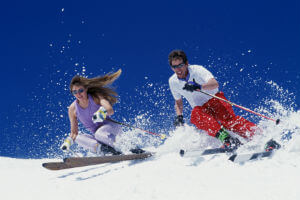Dangers of Spring Ski Roadway Crashes
Posted on behalf of RizkLaw on Mar 13, 2020 in Personal Injury
By Richard Rizk
 Spring skiing in Oregon is a glorious experience! The blue skies, warmer weather, forgiving “corn” snow, grooving slope and side music are ingredients for great fun and sometimes, disaster.
Spring skiing in Oregon is a glorious experience! The blue skies, warmer weather, forgiving “corn” snow, grooving slope and side music are ingredients for great fun and sometimes, disaster.
Here we examine factors that may increase the risk of après ski roadway crashes.
Human Fatigue
Most mountain motorists come to play in the snow, one way or another — whether skiing downhill, cross -country, snow shoeing, or hiking or sledding. Better weather may mean these snow enthusiasts take fewer breaks between excursions, so they may be more fatigued when driving home. The increased elevation only compounds the extreme tiredness, because higher altitude levels decreases oxygen, which can lead to even greater fatigue.
The Long And Winding Road
Springtime mountain motorists usually enjoy clearer roads, but this can also tempt some motorists to drive faster and pass more aggressively. Even in the best of conditions, high altitude motorists face increased driving risks, such as blowing wind gusts, unpredictable wildlife, hairpin turns, steep hills and impatient mountain motorists. Reducing your driving speed may help to minimize these risks.
Vehicle Factors
Engines generally lose two to four percent of power for each 1000 feet of gain. So, more juice under the hood can come in handy at elevation. However, be aware of struggling vehicles on the uphill climb. Conversely, remain alert for out-of-control long haul trucks on steep downgrades.
Spring Après Parties
Springtime brings plenty of mountain party opportunities In Oregon.
Keep in mind that symptoms of altitude may begin to affect some people while they are driving up the mountain, so pull over right away should you notice any lightheadedness. If you intend to drink at your destination, it is important to note that although the altitude will not cause your blood alcohol level to increase, you may perceive an increased buzz.
Keep in mind that some people may be impacted more by altitude changes than others, and since alcohol increases dehydration, you need to drink more water at higher altitudes than you do at sea level.
One final note. Even responsible drivers can be accident victims. Avoiding mountain travel at peak travel times may help you to avoid riskier drivers.
Always pay attention to the road, no matter how beautiful the scenery is, so you can enjoy the mountains again!
Combatting Elevation
As the traditional advice goes, waiting for 48 hours after you reach higher elevation may help. Altitude sickness tends to exhibit itself early on, so 48 hours is usually enough time for most people’s bodies to acclimate.
Once you are back to baseline, if you want to drink alcohol, we recommend going slowly and allowing for plenty of time in-between rounds so you can assess your condition.
Staying hydrated is key if you want to avoid the massive headaches and other foul hangover symptoms you get when you tie one on. Higher altitude locations typically have much less moisture in the air. Since alcohol is a dehydrating diuretic, you need to drink more than the standard sea level approach of “one glass of water for every drink” to stay hydrated. Dehydration will only compound the symptoms of both drunkenness and altitude sickness, so it is important to continue hydrating while drinking and for a while thereafter.
